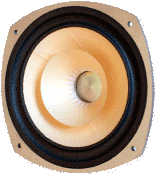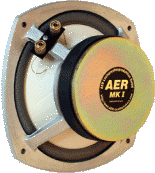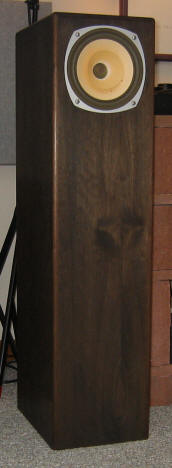Holy alignment-jamming, Batman!
This is an experiment. The AER mk. 1 driver is designed primarily for use in a horn. Well, I don’t want to use it that way! My listening room would not easily accommodate large horns, so I am going to follow the very successful recipe for the Fostex S-168 project and use sealed enclosures for these drivers. The T-S of the AER mk. 1 suggests that this driver should work well in a sealed box. The goal of this project is to use a better driver to improve on the excellent performance I am enjoying from the Fostex project. Also, since the FE168 Sigma driver has been discontinued in favor of the new FE168EZ, which has a much less attractive response curve (more ragged, and +/- 10 dB!), it was time to offer you a crossover-less speaker project using currently available parts.
The goal of this project is to use a better driver to improve on the excellent performance I am enjoying from the Fostex project. Also, since the FE168 Sigma driver has been discontinued in favor of the new FE168EZ, which has a much less attractive response curve (more ragged, and +/- 10 dB!), it was time to offer you a crossover-less speaker project using currently available parts.

A 2 cubic foot sealed enclosure will give a Q=0.6, which should allow very good blending with the Perfect Subs, which also have a system Q of 0.6. The enclosure will be a narrow front baffle floor-stander, with rounded edges and a walnut veneer. Definitely better looking than the Fostex S-168, as befits the AER driver.
 The AER driver’s very high sensitivity of 102 dB will open up many possibilities for amplifiers, especially low powered SETs. I plan to use a Cary 300SEI integrated amplifier as the primary power source. It has a huge 11 watts from the 300B tubes, so power will not be an issue. In fact, this is almost enough power for the Fostex drivers, too. Computer modeling indicates 4 watts will provide SPLs of about 103 dB at the listening position. For me, 100 dB peaks at the listening seat is loud enough, so the 300B amps will be more than sufficient. Internal wiring will once again be Acoustic Zen. I’m told that this wire will soon be available for OEM use, and I urge speaker manufacturers to evaluate this wire at your earliest convenience.
The AER driver’s very high sensitivity of 102 dB will open up many possibilities for amplifiers, especially low powered SETs. I plan to use a Cary 300SEI integrated amplifier as the primary power source. It has a huge 11 watts from the 300B tubes, so power will not be an issue. In fact, this is almost enough power for the Fostex drivers, too. Computer modeling indicates 4 watts will provide SPLs of about 103 dB at the listening position. For me, 100 dB peaks at the listening seat is loud enough, so the 300B amps will be more than sufficient. Internal wiring will once again be Acoustic Zen. I’m told that this wire will soon be available for OEM use, and I urge speaker manufacturers to evaluate this wire at your earliest convenience.
As you can see from the image, the speakers are ready to rock, and rock they certainly do. The volume control on the Cary integrated is about 3 hours lower, i.e. 12:00 instead of 3:00, than the Fostex. These drivers are FAST! The change from the Fostex is similar to upgrading from a Koetsu Urushi to a Rosewood Signature Platinum: there’s just more there. Banish another veil, and all that. Also, the depth and precision of the soundstage is improved over the Fostex speakers, which is saying quite a lot since the Fostex have kept me quite happy for over 2 years with their ability to make music. Initial results are good, but there is more tweaking to do.
I’m still dialing in the subs, since I like DEEP bass, so it is too soon to tell if these AER drivers actually meet their computer model and reach down to the upper 60-low 70Hz range. So far, these are a worthwhile improvement in many areas over the Fostex and seem to meet the expectation that the higher sensitivity of these drivers will result in more information being presented in a clear and musical manner. Hopefully, this project will be another step closer to the elusive goal on our Zen page.
March, 2004 Update: A 9 dB peak centered at 1760 Hz was measured that could not be eliminated even after significant tweaking. The peak is especially irritating because it is only about 60 Hz wide: it starts at about 1730 Hz and is gone by 1790 Hz. It reminds me of that really annoying “zzzzzzzttt” sound a gnat makes as it buzzes by your ear, only a bit higher in frequency. After about 5 minutes of listening, I was looking for a reason – any reason – to turn the music off.
This peak is possibly the same as the one observed on the Fostex S-168, which seemed to be the result of the unsupported whizzer cone. With that driver, the problem occurred about 100 Hz lower in frequency and was eliminated by installing a thin strip of foam between the outside edge of the whizzer cone and the main cone. The peak could also be an indication of cone breakup, a resonance in the enclosure (unlikely, since enclosure problems are usually much lower in frequency), or some other issue that proves that speaker design is equal parts science and art. I have seen similar frequency response problems when trying to use an 8″ driver at too high a cutoff. My guess is that this problem is caused by the whizzer, just like the Fostex. The large gap between the whizzer and the main cone makes adding foam or some other material impractical, since the large added weight would have a serious impact on the very things that make the AER driver attractive: high sensitivity and lightening fast response due to a very light cone. Without more sophisticated test equipment, I can only guess at the cause. But I can tell you that this project in its current form is a “no-go”.
Conclusion: The “take-away” from this project is that I cannot recommend using this driver, or using it in this type of system, irregardless of what the numbers say about its suitability in a sealed enclosure. Also, because of this unusual response peak, I would suggest that any project undertaken with this driver be started only after a thorough investigation of its performance in your intended enclosure.
Click for:
Driver Specifications (65kb PDF)
Enclosure plans (431 kb PDF)
